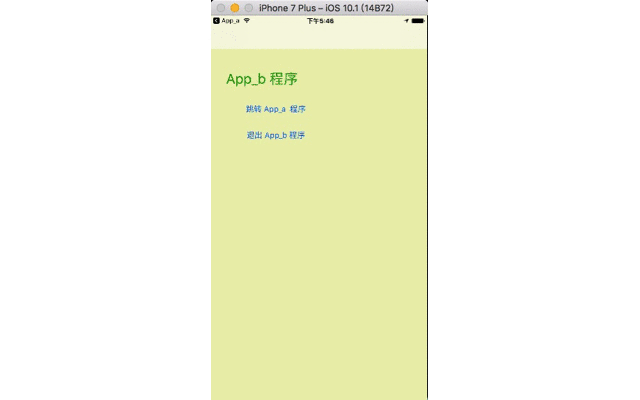今天在做一个音乐播放器的项目,发现这个点击退出程序的功能不能实现终于找到了一些有用的资料,就去网上看了半天资料,下面是退出程序的代码:
在动画里面可以自己添加一些,动画,达到相应的效果。
AppDelegate *app = [UIApplication sharedApplication].delegate;
UIWindow *window = app.window;
[UIView animateWithDuration:1.0f animations:^{
window.alpha = 0;
window.frame = CGRectMake(0, window.bounds.size.width, 0, 0);
} completion:^(BOOL finished) {
exit(0);
}];
在一个程序中打开另一个应用程序 参考
应用之间跳转的原理:
在iOS中打开一个应用程序只需要拿到这个应用程序的协议头即可,所以我们只需配置应用程序的协议头即可。
假设有应用A和应用B两个应用,现在需要从应用A跳转到应用B中。
- 原理:通过设置跳转到应用B的URL Schemes(自定义的协议头),应用B将其自身“绑定”到一个自定义URL Schemes上,就可以从应用A中利用应用B的URL Schemes启动应用B了。
具体怎么做呢,下面一步步来教你,先来个简单点的:从应用A跳转到应用B。设置App-B的URL Schemes
应用A跳转到应用B
- 首先我们用Xcode创建两个iOS应用程序项目,项目名称分别为App-A、App-B。
- 选择项目App-B -> TARGETS -> Info -> URL Types -> URL Schemes,设置App-B的URL Schemes为AppB。

在应用程序App-A中添加一个用来点击跳转的Button,并监听点击事件,添加跳转代码。
//添加跳转按钮
- (IBAction)jumpToAppB:(id)sender {
// 1.获取应用程序App-B的URL Scheme
NSURL *appBUrl = [NSURL URLWithString:@"AppB://"];
// 2.判断手机中是否安装了对应程序
if ([[UIApplication sharedApplication] canOpenURL:appBUrl]) {
// 3. 打开应用程序App-B
[[UIApplication sharedApplication] openURL:appBUrl];
} else {
NSLog(@"没有安装");
}
}
注意:
- 如果是iOS9之前的模拟器或是真机,那么在相同的模拟器中先后运行App-B、App-A,点击按钮,就可以实现跳转了。
- 如果是iOS9之后的模拟器或是真机,那么则需要再在应用程序App-A中将App-B的URL Schemes添加到白名单中,原因和做法如下。
- iOS9引入了白名单的概念。
- 在iOS9中,如果使用
canOpenURL:方法,该方法所涉及到的 URL Schemes 必须在"Info.plist"中将它们列为白名单,否则不能使用。key叫做LSApplicationQueriesSchemes ,键值内容是对应应用程序的URL Schemes。
具体做法就是在App-A的Info文件中,添加LSApplicationQueriesSchemes数组,然后添加键值为AppB的字符串。

添加LSApplicationQueriesSchemes数组,然后添加键值为AppB的字符串
添加白名单之后在相同的模拟器中先后运行App-B、App-A,点击按钮,就可以实现跳转了。
假设有两个程序如下: App_a、App_b,我们要是现在 App_a 里触发某个事件去打开 App_b,具体实现如下所示:
建立一个新的项目 App_a 步骤如下所示:

在 App_a 中设置跳转按钮,如下所示:

并做好关联,在 ViewController.m 中的代码如下所示:
#import "ViewController.h"
#import "AppDelegate.h"
@interface ViewController ()
@end
@implementation ViewController
- (void)viewDidLoad {
[super viewDidLoad];
// Do any additional setup after loading the view, typically from a nib.
}
// 跳转到 App——b
- (IBAction)backToApp_b_method:(UIButton *)sender {
// 1.获取应用程序App-B的URL Scheme
// 下面代码是跳转的关键代码;AppB:// 就是我们第二个 APP 的 URL Schemes 。
NSString *urlStr = @"AppB://";
NSURL *url = [NSURL URLWithString:urlStr];
// 2.判断手机中是否安装了对应程序
if ([[UIApplication sharedApplication] canOpenURL:url]) {
// 3. 打开应用程序App-B
[[UIApplication sharedApplication] openURL:url];
} else {
NSLog(@"没有安装");
}
}
// 退出 App——a 程序
- (IBAction)exitApp_a_method:(UIButton *)sender {
AppDelegate *app = [UIApplication sharedApplication].delegate;
UIWindow *window = app.window;
[UIView animateWithDuration:1.0f animations:^{
window.alpha = 0;
window.frame = CGRectMake(0, window.bounds.size.width, 0, 0);
} completion:^(BOOL finished) {
exit(0);
}];
}
- (void)didReceiveMemoryWarning {
[super didReceiveMemoryWarning];
// Dispose of any resources that can be recreated.
}
@end
在 App_a 的 info 文件中设置如下:

我们这里已经将错误的 URL Schemes 改为正确的 如下所示:

在 App_b 中也做如上的设置,新建 App_b ,设置 info.plist 文件, 在 info.plist 文件里添加 LSApplicationQueriesSchemes 数组,在数组中插入一个字符串元素为 App_a 就是一个能够打开的 App 的名字, 在 URL Types 里新增 URL (AppB) 并绑定 App_b 的 bundleID (com.jw.AppB) 如下图所示。

在 App_b 的 Main 文件里也做几个按钮,用于跳转到 App_a 中 并做好sb 与代码的关联,代码如下:
#import "ViewController.h"
#import "AppDelegate.h"
@interface ViewController ()
@end
@implementation ViewController
- (void)viewDidLoad {
[super viewDidLoad];
// Do any additional setup after loading the view, typically from a nib.
}
// 跳转到 App——a 程序
- (IBAction)backToApp_a_method:(UIButton *)sender {
// 下面代码是跳转的关键代码;App_a:// 就是我们第一个 APP 的 URL Schemes 。
NSString *urlStr = @"AppA://";
NSURL *url = [NSURL URLWithString:urlStr];
[[UIApplication sharedApplication] openURL:url];
}
// 退出 App——b 程序
- (IBAction)exitApp_b_method:(UIButton *)sender {
AppDelegate *app = [UIApplication sharedApplication].delegate;
UIWindow *window = app.window;
[UIView animateWithDuration:1.0f animations:^{
window.alpha = 0;
window.frame = CGRectMake(0, window.bounds.size.width, 0, 0);
} completion:^(BOOL finished) {
exit(0);
}];
}
- (void)didReceiveMemoryWarning {
[super didReceiveMemoryWarning];
// Dispose of any resources that can be recreated.
}
@end
此时运行两个 App ,我们在 App_a 的页面中点击跳转到 App_b 就能够实现页面的跳转了。
应用App_a跳转到应用App_b的特定界面
很多时候,我们做应用程序之间的跳转并不只是跳转到其他程序就可以了,而是要跳转到其他程序的特定页面上。比如我们在浏览网页时,会有分享到微信朋友圈或是分享给微信朋友,这就需要跳转到微信朋友圈界面或是微信朋友选择界面。
具体如何做呢?
1、首先我们先来为App-b搭建两个页面 FFPageViewController 和 HHPageViewController 。这里用导航控制器 Push 两个 ViewController,通过Push 来进入 FFPaeViewControler 所以将 FFPageViewController 的页面标示绑定为 FFPage,通过Storyboard Segue设置HHPageViewController的标识符绑定,"HHPage"。之所以这样做,是为了实现两种技术下的页面跳转。如下所示:


代码为:
Appdelegate.m 文件修改代码如下:
#import "AppDelegate.h"
#import "ViewController.h"
#import "FFPageViewController.h"
@interface AppDelegate ()
@end
@implementation AppDelegate
- (BOOL)application:(UIApplication *)application didFinishLaunchingWithOptions:(NSDictionary *)launchOptions {
// Override point for customization after application launch.
return YES;
}
- (BOOL)application:(UIApplication *)app openURL:(NSURL *)url options:(NSDictionary<UIApplicationOpenURLOptionsKey,id> *)options{
// 1.获取导航栏控制器
UINavigationController *rootNav = (UINavigationController *)self.window.rootViewController;
// 2.获得主控制器
ViewController *mainVc = [rootNav.childViewControllers firstObject];
// 保存完整的App-A的URL给主控制器
mainVc.urlString = url.absoluteString;
// 3.每次跳转前必须是在跟控制器(细节)
[rootNav popToRootViewControllerAnimated:NO];
// 4.根据字符串关键字来跳转到不同页面
if ([url.absoluteString containsString:@"FFPage"]) { // 跳转到应用App_b的FFPage页面
UIStoryboard *storyboard = [UIStoryboard storyboardWithName:@"FFPageViewController" bundle:[NSBundle mainBundle]];
FFPageViewController * ffPage = [storyboard instantiateViewControllerWithIdentifier:@"FFPageViewController"];
ffPage.urlString = mainVc.urlString;//传递原来的App 的 URL scheme
[mainVc.navigationController pushViewController:ffPage animated:YES];
} else if ([url.absoluteString containsString:@"HHPageSegue"]) { // 跳转到应用App_b的HHViewController页面
// 根据segue标示进行跳转
[mainVc performSegueWithIdentifier:@"HHPageSegue" sender:nil];
}
return YES;
}
@end
ViewController.h文件修改
#import <UIKit/UIKit.h>
@interface ViewController : UIViewController
// 用来保存App_a完整的URL
@property (nonatomic, copy) NSString *urlString;
@end
ViewController.m文件修改
#import "ViewController.h"
#import "AppDelegate.h"
#import "HHViewController.h"
@interface ViewController ()
@end
@implementation ViewController
- (void)viewDidLoad {
[super viewDidLoad];
// Do any additional setup after loading the view, typically from a nib.
}
// 跳转到 App——a 程序
- (IBAction)backToApp_a_method:(UIButton *)sender {
// 1.获取应用程序App-A的URL Scheme
// 下面代码是跳转的关键代码;App_a:// 就是我们第一个 APP 的 URL Schemes 。
NSString *urlStr = @"AppA://";
NSURL *url = [NSURL URLWithString:urlStr];
// 2.判断手机中是否安装了对应程序
if ([[UIApplication sharedApplication] canOpenURL:url]) {
// 3. 打开应用程序App-A
[[UIApplication sharedApplication] openURL:url];
} else {
NSLog(@"没有安装");
}
}
// 退出 App——b 程序
- (IBAction)exitApp_b_method:(UIButton *)sender {
AppDelegate *app = (id)[UIApplication sharedApplication].delegate;
UIWindow *window = app.window;
[UIView animateWithDuration:1.0f animations:^{
window.alpha = 0;
window.frame = CGRectMake(0, window.bounds.size.width, 0, 0);
} completion:^(BOOL finished) {
exit(0);
}];
}
// 使用 segue 进行跳转
- (void)prepareForSegue:(UIStoryboardSegue *)segue sender:(id)sender
{
if ([segue.identifier isEqualToString:@"HHPageSegue"]) {
// 获得将要跳转的界面HHViewController的控制器
HHViewController *HHPage = segue.destinationViewController;
// 保存完整的App_a的URL给跳转界面HHViewController,方便后期能够返回的操作等....这里不再写了
HHPage.urlString = self.urlString;
}
}
- (void)didReceiveMemoryWarning {
[super didReceiveMemoryWarning];
}
@end
FFPageViewController.h 文件
#import <UIKit/UIKit.h>
@interface FFPageViewController : UIViewController
// 用来保存App_a完整的URL
@property (nonatomic, copy) NSString *urlString;
@end
FFPageViewController.m 文件
#import "FFPageViewController.h"
@interface FFPageViewController ()
@end
@implementation FFPageViewController
- (void)viewDidLoad {
[super viewDidLoad];
// Do any additional setup after loading the view.
}
// 返回 App_a 程序
- (IBAction)backToApp_aMethod:(UIButton *)sender {
// 1.拿到对应应用程序的 URL Schemes
NSString *urlSchemeString = [[self.urlString componentsSeparatedByString:@"?"] lastObject];
NSString *urlString = [urlSchemeString stringByAppendingString:@"://"];
// 1.获取对应应用程序的URL
NSURL *url = [NSURL URLWithString:urlString];
// 2.判断是否可以打开
if ([[UIApplication sharedApplication] canOpenURL:url]) {
[[UIApplication sharedApplication] openURL:url];
}else {
NSLog(@"没有安装原来的程序,着说不通啊,你是咋跳转过来的昂?");
}
}
- (void)didReceiveMemoryWarning {
[super didReceiveMemoryWarning];
// Dispose of any resources that can be recreated.
}
/*
#pragma mark - Navigation
// In a storyboard-based application, you will often want to do a little preparation before navigation
- (void)prepareForSegue:(UIStoryboardSegue *)segue sender:(id)sender {
// Get the new view controller using [segue destinationViewController].
// Pass the selected object to the new view controller.
}
*/
@end
在 HHViewController.h 文件里添加属性 urlString 字段。
在 HHViewController.m 文件里添加如下代码,并与 StoryBoard 文件关联:
// 返回 App_a 程序
- (IBAction)backTo_App_aMethod:(UIButton *)sender {
// 1.拿到对应应用程序的URL Scheme
NSString *urlSchemeString = [[self.urlString componentsSeparatedByString:@"?"] lastObject];
NSString *urlString = [urlSchemeString stringByAppendingString:@"://"];
// 1.获取对应应用程序的URL
NSURL *url = [NSURL URLWithString:urlString];
// 2.判断是否可以打开
if ([[UIApplication sharedApplication] canOpenURL:url]) {
[[UIApplication sharedApplication] openURL:url];
}else {
NSLog(@"没有安装原来的程序,着说不通啊,你是咋跳转过来的昂?");
}
}
2、然后再在 App_a 中添加一些用来跳转的页面,并进行关联,如下所示:

3、注意,从应用程序 App_b 跳回 App_a 的实现原理如下:
步骤分析:
- 我们想要从应用B再跳转回应用A,那么在跳转到应用B的时候,还应将应用A的URL Schemes传递过来。这样我们才能判断应该跳转回哪个应用程序。
- 这样我们指定一个传递URL的规则:
协议头://应用B的URL Schemes?应用A的URL Schemes。即:AppB://Page1?AppA。 - 说明:
- AppB是跳转过来的应用App-B的URL Schemes;
- Page1是用来区别跳转页面的标识;
- ? 是分割符;
- AppA是跳转回的应用App-A的URL Schemes
- 我们根据传递来的数据,进行反跳回去。
- 之前我们在应用App-B中通过
AppDelegate执行不同页面的跳转。在对应方法中我们可以拿到完整的URL,在主控制器ViewController中设定一个属性,将该URL保存在主控制器中。 - 在主控制器中我们可以通过
- (void)prepareForSegue:(UIStoryboardSegue *)segue sender:(id)sender;方法获取将要跳转的页面控制器。 - 在将要跳转的页面控制器中定义一个属性,用于接受、截取出跳转回的应用(即App-A)的URL Schemes,执行跳转。
4、实现效果图如下:
首先运行两个程序,保证安装成功。




















